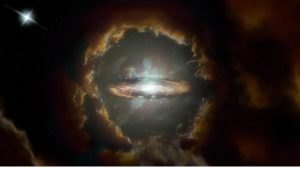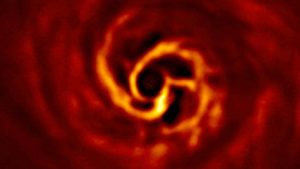Media
Transcript
Today’s news starts with one of those stories that make it clear, the kids are ok.
Last summer, undergraduate Rebecca Minsley traveled to the University of Hawaii at Manoa’s Institute for Astrophysics to take part in a summer Research Experience for Undergraduates program. Commonly just called an REU, these internships are a right of passage for the majority of future researchers. I was an REU student at Kitt Peak’s National Radio Astronomy Observatory, and I have had my own summer students on related programs when I was at Harvard many years ago.

Normally, students do their best on a 10-week project, and the expectation is that some small science will be completed that might lead to a publication or a software release. Well, for Rebecca Minsley, the science she worked on was less of an incremental improvement in understanding and more of a revolution in understanding. Her work, under mentor Dr. Andreea Petric, looked at myriad images of merging galaxies and sought to understand how supermassive black holes grow by looking at the gas dynamics. According to the press release, “Minsley studied the shapes of 630 galaxies using images from the Pan-STARRS survey. She classified the galaxies into mergers, early mergers, and non-mergers. And then compared the shapes to the light output of the same galaxies at longer mid-infrared wavelengths, where she could study the properties of the interstellar medium.”
The result? They found that galaxy merger shocks heat gas in galaxies, and this heating prevents the formation of stars, allowing the gas to flow into the supermassive black hole, triggering black hole growth in step with the galaxies growing through the merger. This is the first step in developing the clean solution that astronomers have been looking for, but it is a first step that requires finding someone with 10 weeks to analyze 630 images, someone who was careful, smart, and cheaper than a Ph.D. This student fit the bill, and I can’t wait to see what she does in the future.
Our next two stories may trigger a sense of deja vu. We’re at this weird place in astronomy where lots of teams using lots of telescopes are discovering the same things while looking at different objects, and due to the sometimes amusing timing of press releases, we’re seeing these results getting premiered with equal fanfare from each institution. It’s the scientific equivalent of two networks premiering almost identical shows in their fall lineup; only with science, it’s more reinforcing the facts rather than dividing the audience.

In our first story of science on repeat, a week after talking about a survey of galaxies formed in the early universe that rotates, we are getting a new press release announcing that the Atacama Large Millimeter/submillimeter Array has discovered a particularly massive galaxy in the early universe. DLA0817g is the most distant galaxy found to be rotating. Its light started the journey to our telescopes just 1.5 billion years after the universe formed, and to get a massive galaxy fully formed this early in the universe would require this particular system to grow through the accumulation of massive amounts of cold gas that collapse en masse into this system.
In astronomy, we sometimes talk about how galaxies form either through a bottom-up or a top-down approach, where either a myriad of small galaxies come together through mergers to form giant systems — this is what we talked about last week — or a singular mass of gas collapses into a giant galaxy in one turbulent event. This week’s big, rotating, early-forming galaxy is of the singular collapse variety. Sometimes, there are lots of ways to get to the same outcome, and it’s not “either/or” but instead “and” when it comes to ways to make galaxies grow.

In our final story of the day, we have an echo of Tuesday’s story of planet formation as seen with Keck. Today, we have news from the Very Large Telescope about AB Aurigae, a young variable star 520 light-years away. When observed in the infrared, a spiral in the disk of gas and dust in this system indicates the presence of a forming planet at a Neptune-like distance from the star. This multiple-instruments finding multiple ways to find planets at different stages in their formation is going to allow us to build a complete understanding of planet formation… eventually. These are early days, with each new world getting a shiny new press release to announce its imaging. It’s only after this becomes a normal thing to image that we’ll begin to have enough data to really understand what’s going on.
Learn More
UH REU student helps reveal how galaxies and black holes grow together
- University of Hawai’i Institute for Astronomy press release
- “Molecular Gas and Dust Heating in Active Galaxies: Growing Black Holes or Tidal Shocks?,” Rebecca Minsley et al., 2020 May 18, The Astrophysical Journal (Preprint on arxiv.org)
ALMA Discovers Massive Rotating Disk in Early Universe
- National Radio Astronomy Observatory press release
- Max Planck Institute press release
- “A Cold, Massive, Rotating Disk 1.5 Billion Years After the Big Bang,” Marcel Neeleman, J. Xavier Prochaska et al., 2020 May 20, Nature (DOI: https://doi.org/10.1038/s41586-020-2276-y)
Very Large Telescope Sees Signs of Planet Birth
- ESO photo release
- “Are We Witnessing Ongoing Planet Formation in AB Aurigae? A Showcase of the SPHERE/ALMA Synergy“, A. Boccaletti et al., 2020 May 20, Astronomy & Astrophysics (Preprint from ESO)
Credits
Written and Hosted by Pamela Gay
Audio and Video Editing by Ally Pelphrey
Content Editing by Beth Johnson
Intro and Outro music by Kevin MacLeod, https://incompetech.com/music/


 We record most shows live, on Twitch. Follow us today to get alerts when we go live.
We record most shows live, on Twitch. Follow us today to get alerts when we go live.